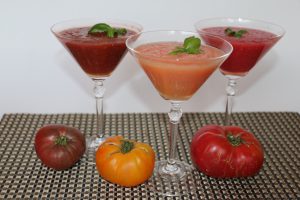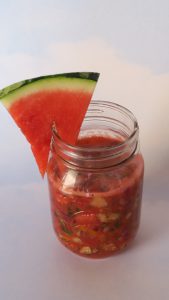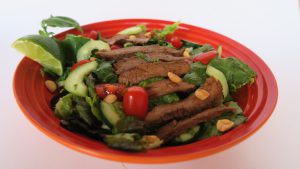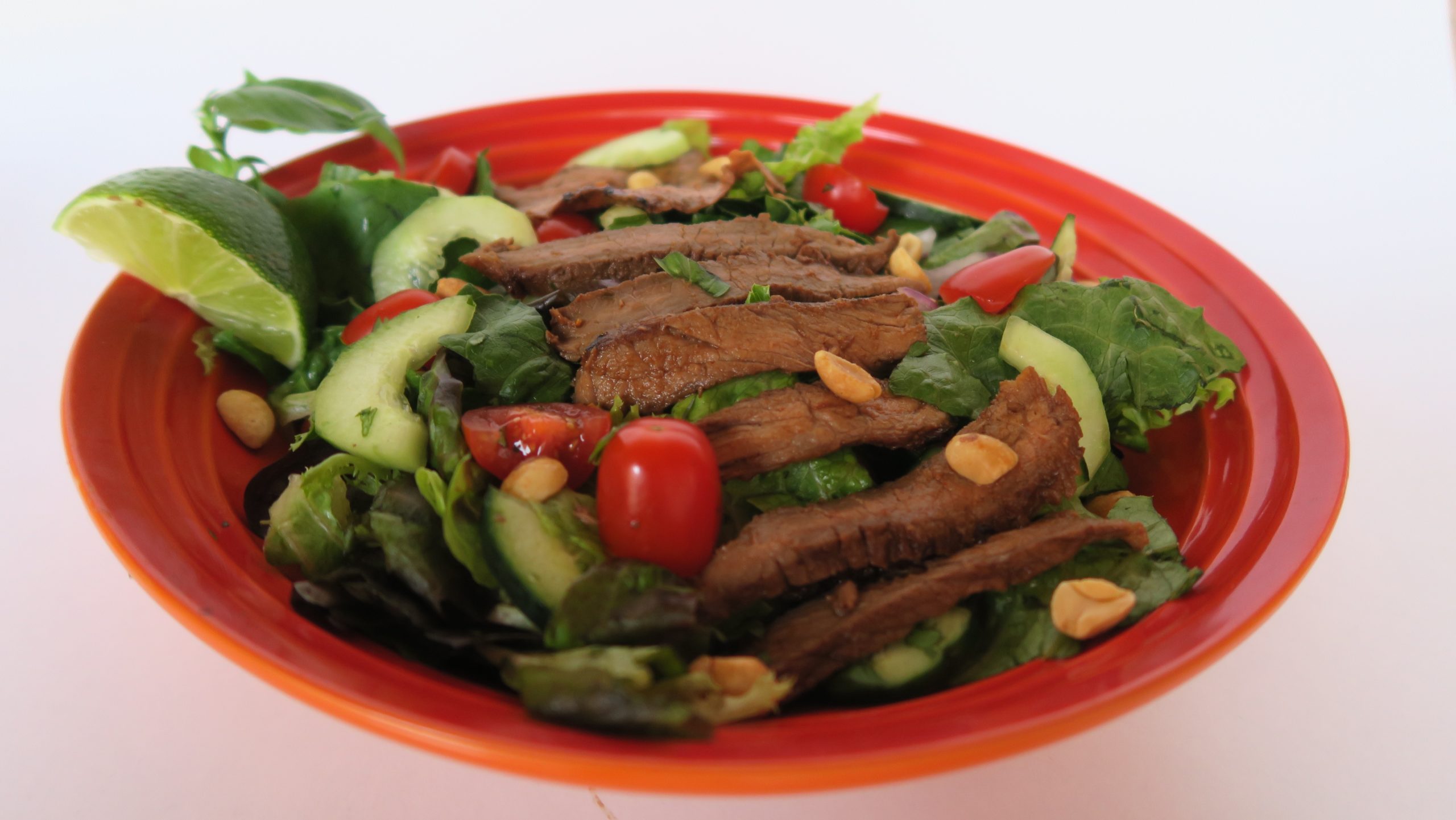Kids are back in school and Labor Day is in the rear view mirror. The calendar tells us summer will be over in a couple of weeks, but as long as fresh fruit is still available at our local growers’ markets, it will taste like summer.

Once you have good tomatoes, nothing is faster to make than Iced Tomato Soup. If you want to add texture, peel, seed and dice some extra tomatoes and/or local cucumbers. (Photo by Denise Miller.)
It has been a good year for local apricots, cherries, blackberries and peaches. And since August, early apples, plums, pears, cantaloupes, canary and casaba melons, and watermelons have graced market tables, along with the tasty backyard tomatoes that we wait for all year.
Classifying tomatoes as fruit (versus vegetable) is not new. Their seed-bearing structure – rather than the fact that we don’t make tomato cakes – makes it so. But there are also plenty of fruits that we forget to define this way, like cucumbers, olives, corn, peppers, eggplants and legumes.
Vegetables, on the other hand, from a botanical point of view, are the non-flowering bits, or the roots, leaves and stems. But unlike many fruits that we call vegetables, there don’t seem to be many vegetables that are considered as fruits. Rhubarb is an exception: we eat it for dessert but it is actually a vegetable.
Whether you are a botanist or chef, eating locally grown fruit is a pleasure worth pursuing! Even if you are watching the amount of carbohydrates you are eating, some types of fruit have fewer carbs per serving, mostly due to their higher water content, or they have fewer absorbable carbohydrates due to their high fiber content.
Locally grown fruit is generally picked ripe and ready-to-eat. The sweetness that develops from plenty of sunshine and cool nights distills the flavors like only New Mexico can. Here are three of our favorite low-carb fruits still available in September.
MELONS: Watermelon is the quintessential summer fruit and it scores lowest in carbohydrate content. It’s low in fiber, so most of this carbohydrate is absorbed. Watermelon is also high in vitamin A and has a high water content, which will fill you up while providing fewer calories. Look for tasty seedless varieties that are excellent for using in recipes. Cantaloupes and other orange-fleshed melons are high in beta carotene, and small canary, crenshaw and casaba melons (also called Native melons) are high in vitamin A and C.
CUCUMBERS: Cucumbers are a refreshing and nutritious addition to any salad, quick-pickled, or added to a cold soup. Peeled or unpeeled they are near the lowest for the amount of carbohydrates they contain. Look for different varieties such as Armenian cucumbers (long, narrow), lemon cucumbers (small, round), many slicing varieties, and pickling cucumbers.
TOMATOES: Tomatoes are low in carbs and have additional fiber, meaning they net even lower. Cook them into sauces, or enjoy them raw as a healthy snack with salt and pepper, as toppings on salads or sandwiches, or in warm or cold soups. This time of year, the hardest decision is what type of tomatoes to buy. Best idea: try them all!
Don’t let September’s locally grown fruits and vegetables pass you by. Spending time at a growers’ market is the best way to end your summer on a sweet note.
Denise Miller is executive director of the New Mexico Farmers’ Marketing Association. Visit FarmersMarketsNM.org and DoubleUpNM.org.

Fresh, colorful Watermelon and Cucumber Gazpacho makes a great summer starter. The raw vegetables give it crunch and a truly healthy taste. (Photo by Denise Miller.)
WATERMELON AND CUCUMBER GAZPACHO
Makes 6-8 servings
- 1 5-pound seedless watermelon, diced (about 8 cups), divided
- 1 small cucumber, peeled, seeded, diced (about 1 cup)
- 1 medium-size red bell pepper, seeded, diced (about 1 cup)
- 1 medium-size yellow bell pepper, seeded, diced (about 1 cup)
- 1 small jalapeño chile, seeded, minced
- 3 pale green inner celery stalks, diced (about ½ cup)
- ½ small red onion, diced (about 1 cup)
- ¼ cup finely chopped fresh mint
- 3 tablespoons fresh lime juice
- 2 tablespoons red wine vinegar
- ¼ teaspoon salt
- ½ cup crème fraîche or sour cream (optional)
Puree 7 cups watermelon in blender until smooth. Transfer puree to large bowl. Add remaining 1 cup diced watermelon and next 10 ingredients; stir to combine. Cover gazpacho and refrigerate until cold, at least one hour and up to four hours.
Divide gazpacho among bowls; top with dollop of crème fraîche (optional).
ICED TOMATO SOUP
Makes about 1 quart
- 2 red, 2 yellow, and 2 (or more because they’re often smallish) green zebra tomatoes
- Sea salt and freshly ground pepper
- Fresh lemon juice or vinegar to taste
- Extra virgin olive oil to taste
- Minced opal basil, marjoram, lemon basil, dill or lovage
Puree each color tomato separately in a blender until smooth.
Chill well, then season each batch to taste with lemon juice or vinegar, and olive oil, using about a teaspoon of oil per serving.
Pour the purees into chilled glasses, one type to a glass or in separate layers, and garnish with the fresh herbs and freshly ground pepper.
Adapted from “Vegetable Soups from Deborah Madison’s Kitchen,” Broadway Books, 2006

Be sure to incorporate as many local ingredients as you can into this satisfying Thai Beef Salad, including New Mexico-raised beef, if possible. The sweet and spicy marinade brings out fruity notes of the cherry tomatoes and cucumbers. (Photo by Denise Miller.)
THAI BEEF SALAD
Serves 4-6
- 2 pounds steak (London broil, round or flank steak; about 1 to 1½-inches thick)
DRESSING:
- Juice from 2 medium limes
- 2 tablespoons orange juice
- ½ cup soy sauce
- 2 tablespoons red chile-garlic sauce (adjust to taste)
- 2 tablespoons vegetable oil
- 2 tablespoons brown sugar
- 3-5 cloves minced garlic
- 2 tablespoons minced ginger (adjust to taste)
- 1/8 teaspoon white pepper
- ½ teaspoon onion powder
SALAD:
- 6-8 cups mixed lettuce greens
- 1 small red onion sliced thin
- 2 small/medium cucumbers cut in half then sliced into thin half-moons
- 1-2 cups of cherry tomatoes sliced in half
- ½ cup chopped cilantro leaves
- ½ cup basil leaves, sliced into ribbons
EXTRAS:
Chopped peanuts for garnish
Chopped cilantro, basil or mint for garnish
Combine dressing ingredients. Split the mixture in half, setting aside one half for the dressing. Marinate steak in the other half (overnight if possible).
Grill steak on stovetop or broil in oven to get nice char on meat. Cook to medium rare. Let rest and then slice thinly across the grain.
Take remaining dressing and blend with 1 or 2 tablespoons of additional oil to make dressing. Season to taste.
Mix vegetables and greens together in large bowl. Use two-thirds of dressing to dress salad. Plate greens in bowl and add steak slices on top. Garnish with peanuts and/or chopped cilantro, basil or mint. Drizzle remaining dressing over top as desired.





